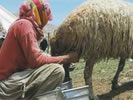Eye For Film >> Movies >> The Last Season: Shawaks (2009) Film Review
The current fashion in documentaries is very much about sharp edits, energetic pacing and fast talking, so it's refreshing to see a film like this that takes a step back and simply lets the camera linger. Made by Kazim Oz, who grew up in this remote region of eastern Turkey, it's a portrait of the Shawaks people whose nomadic lifestyle carries them through these mountains in a cyclical, seasonal pattern.
In Winter the snow is beautiful; in Spring the lambs are born; in Summer the heat brings laziness and quarrels; and Autumn is the time of separation. All this seems to have gone on forever and it shows little sign of changing, though some of the men are unhappy with their lot and some of the women whisper about feminism. Throughout the film is carried by the wild, swirling music and the songs the people sing, and by the sound of the wind that tears across the hills.

As a documentary maker, Oz is almost invisible, preferring simply to observe, though he and his crew produce a cute self portrait in shadow on the snow at the end. One notable exception occurs when the women accuse the men of beating them. Pursuing the question leads suddenly to an explosive confrontation, with the men demanding to know what he is doing there, concerned that they will be represented to outsiders as buffoons. But Oz is unwilling to portray them as saints, and in time extracts a brutal admission.
Life in the mountains is hard - that's not in doubt. Still, as some of the men struggle to pinpoint exactly what is hard about it, the film gently questions our preconceptions about this lifestyle and our willingness to make allowances. Though these people live far from the comforts of city life, they are not unsophisticated. They are not without their own agenda. By simply watching, we get closer to the core of who they are than any pushier film could have done.
Central to the Shawaks' lives are the lives of their animals, and these are also an important focus of the film, as they struggle through the hills protesting at their burdens, bound around in the innocence of youth or call to one another in a manner that evokes the gossip of the people themselves. Community is essential to survival here, and the animals are a part of it. When the time of separation comes, the men sorrowfully kiss them goodbye outside the slaughterhouse.
Beautifully filmed and fascinating throughout, this is a little gem of a film, a real pleasure.
Reviewed on: 24 Dec 2009

















